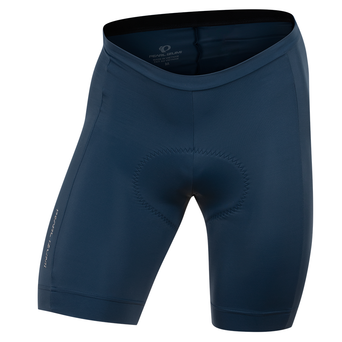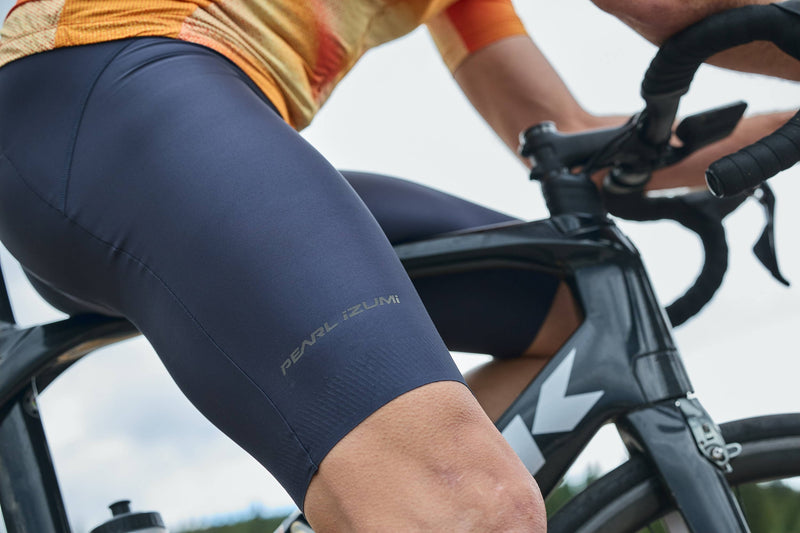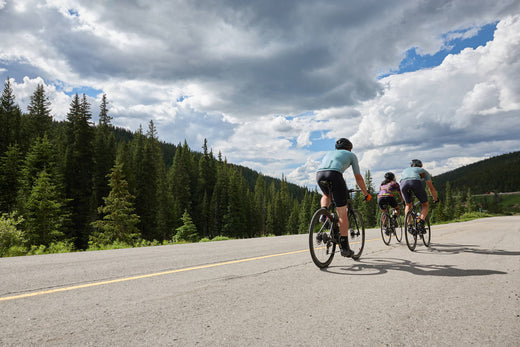The winter of 2022-2023 has been one for the books, with much of the western United States recording historic precipitation amounts. As I write this in early April 2023, several ski resorts, including the Mammoth Lakes Ski Resort, in northern California, and the Alta Ski Area, in Utah, have both recorded historic amounts of snowfall, at 705” and a whopping 877” of snow, respectively. That’s over 73 feet of snow!
Even in regions of the US that are more mild, this winter has seen more precipitation and more cold temperatures in longer durations than usual. Cyclists have persevered with the usual tactics: hitting the trainer, piling into indoor cycling studios, and, out of necessity as winter drags on, embracing PEARL iZUMi’s motto of RIDE 365, and finding ways to ride outside all year long.
Spring riding is awesome – if you dress appropriately. How to Dress for Winter Cycling. In addition to the normal benefits, such as fitness, fun, and basic community transportation, cold weather riding is incredibly peaceful as the roads and trails are often noticeably less crowded. But there is an unexpected challenge to riding outdoors in winter and early spring: hydration in cold weather.
Riders focus intently on staying hydrated while cycling during the warmer months yet come up short on water consumption when it’s chilly. The association between dehydration and cold weather is somehow less prevalent, in part because we sweat less when it’s cold outside, and the air is often less humid. However, your body loses moisture all day, regardless of temperature, through respiration, sweating, urination, and more. And a high effort physical activity like riding your bike can significantly increase moisture loss.
In cold climates, body fluid losses can be as high as those in hot climates because of high rates of energy expenditure, use of heavy clothing and increased losses in urine, said the European Hydration Instititute.
It’s Easy to Experience Dehydration in Cold Temperatures
To get a better understanding of how easy it is to experience dehydration in winter, we asked the deeply experienced PEARL iZUMi Athlete Ambassador team to share their experiences with getting enough water when it’s cold.
Brooke Goudy, a bikepacker/endurance racer and prominent advocate for Diversity, Equity and Inclusion on bikes and trails, shared that she sometimes struggles in this area. “When it comes to hydrating in the winter, I am the worst! I don’t have all those indicators that summer biking screams at you as a reminder to drink water…like sweating, feeling thirsty, and even friendly reminders from your group to keep drinking because it is a hot summer day,” she said. Brooke recommends riders use available tools like your phone or bike computer to set drink reminders, or simply to drink some water every few miles, or at every stop, such as an intersection.
Marley Blonsky, Co-Founder of All Bodies on Bikes, agreed: “Staying hydrated on cold rides is nearly impossible for me – a game changer was setting up custom alerts on my Wahoo to remind me to drink every 20 mins. Even though it’s annoying to get that reminder, it really does help me remember to keep drinking!”
In addition to remembering to drink water, there are other challenges unique to cold environments. Alexey Vermeulen, professional cyclist and winner of last year’s Belgian Waffle Ride in California, shared one such challenge. “Growing up in Michigan, the conversation used to always be about making a concoction that wouldn’t freeze…but nowadays with more insulated bottle options available, I tend to focus on things that taste best and help me get excited to drink! When it is really cold, I tend to lean towards more vibrant tastes like tart cherry juice or tea with honey,” he said.
Getting enough water year-round is critical. Medical professionals from sources like the Mayo Clinic and the European Hydration Institute agree: adults need around 100 ounces of water each day, regardless of temperature. And adult athletes in training mode, obviously, require more to fulfill the increased demands on their bodies.
Tips: How to Stay Hydrated While Cycling
Taking steps to help remember to drink more water in the winter can help by preventing dehydration and also can improve athletic performance. Training in the winter can give athletes a valuable advantage over fair weather competition, and drinking enough water provides more advantage still. Simply being conscious of our tendency to drink less in winter is a great way to begin.
For Rebecca Brough, Associate Marketing Manager at PEARL iZUMi and a competitive road and gravel rider, says she starts early. “I’ve been focusing on drinking warm water in the morning, either before or instead of drinking coffee. Sometimes in the winter you don’t really want a cold drink and so warm water, or even warm water with a tasty flavor from Skratch, is more appealing and helps you stay hydrated while working out,” she said.
Whit Allison, Co-Founder of the FoCo Fondo and PEARL iZUMi Athlete-Ambassador, agreed. “I find drinking during cold outdoor winter riding pretty difficult and I honestly usually end up a bit low on the consumption. Starting hydrated is really important in winter for this reason. I do try to bring the amount of hydration I should be consuming with me on a ride, even if I fall short. In the Allison household, we call this "carrying around your intentions," she said.
She also suggested bracketing any food you eat with several gulps of water, which in addition to helping achieve hydration goals, helps the nutrition go down easier and digest faster. And she recommended finding apparel that doesn’t present an obstacle for a nature break after drinking. “I will add that the Pearl iZUMi drop-tail bibs are a game changer for hydration in that having to pee no longer means a very long, drawn out process of removing layers,” she said. Shop Women’s Bib Shorts.
And finally, both Brook Goudy and Jake Magee, mid-distance gravel racer and record holder for fastest Gravel Worlds 75 mile race, both recommended drinking every time your bike pauses, and to add more stops to your ride. “For hydration and fueling while outdoor winter training, I always try to add in more stops, things like cafes, gas stations and bakeries. Purely for the fact that you get the chance to go inside a building and warm up! It’s always a good opportunity to fill your bottles with some warm water or coffee. I find it keeps morale high so you can get a nice long ride in,” said Magee.
Summary
- It can be challenging, even for experienced cyclists, to drink enough water during colder months.
- We lose water all the time, year-round, through perspiration, respiration and urination.
- Simply being conscious of staying hydrated can really help.
- Start with water early in the day of your ride.
- Drink often, via reminders, at stops, or before and after eating.
- Have fun on your bike, even in winter, and crush your (possibly dehydrated) competition!






Comments